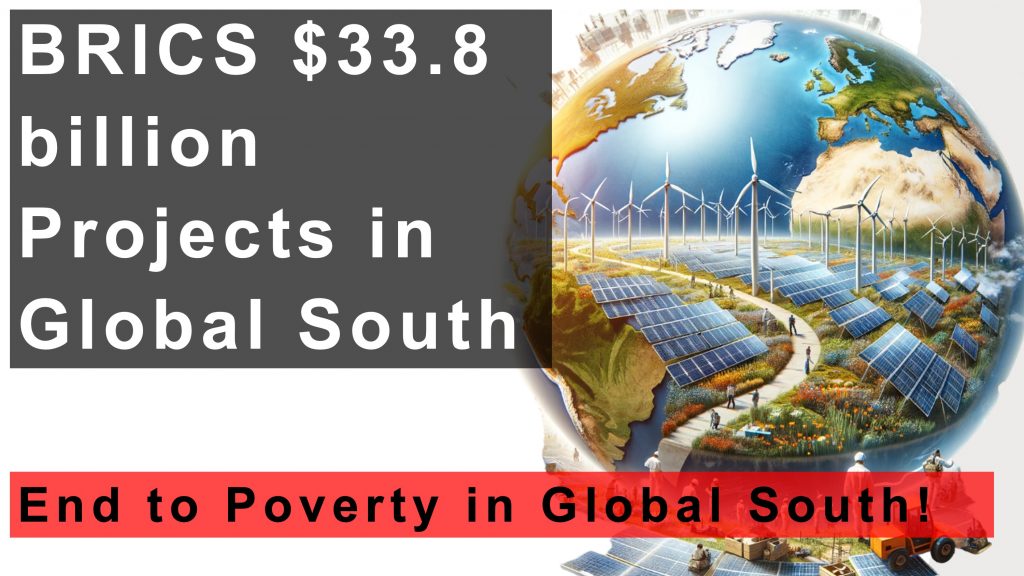The New Development Bank, established by the BRICS nations in 2015, focuses on mobilizing resources for infrastructure and sustainable development projects in BRICS and other emerging market economies and developing countries. The bank prioritizes projects that align with the development objectives of its members. According to the New Development Bank website, the NDB has supported 94 direct investment projects in each member country, amounting to approximately $33.8 billion. The bank has a pipeline of 78 projects for 2023 and 2024 totaling another $18.9 billion.
In this article, we will analyse the projects financed by NDB in various countries including BRICS nations
The Serra Urban Mobility Project
The Serra Urban Mobility Project – Requalifica Serra in Brazil aims to enhance urban mobility and improve infrastructure within the Serra municipality. This project is part of a broader initiative to address urban transportation challenges, improve accessibility for residents, and support sustainable urban development. It reflects the New Development Bank’s commitment to investing in projects that promote social inclusivity, environmental sustainability, and economic development within its member countries.
The Beijing Gas Tianjin Nangang LNG Emergency Reserve Project.
This project, located in Tianjin, aims to establish a liquefied natural gas (LNG) emergency reserve facility. With a proposed loan amount of EUR 436 million from the New Development Bank, its primary objective is to enhance energy security and provide a backup for natural gas supplies in the region. The project is crucial for ensuring a stable energy supply during peak demands or in emergencies, supporting the region’s economic development and environmental goals by facilitating a shift towards cleaner energy sources.
The Qingdao Metro Line Six Project in China.
The Qingdao Metro Line Six project, with a proposed loan of RMB 3,237 million, is an infrastructure initiative aimed at expanding Qingdao’s urban transit system in China. Phase I of this project encompasses the construction of a new metro line that will significantly improve public transportation in the city, reduce traffic congestion, and contribute to the reduction of carbon emissions by encouraging the use of public transport over private vehicles. The metro line will enhance connectivity within the city, facilitating easier and more efficient movement for residents and visitors alike, thus supporting Qingdao’s urban development and economic growth.
Now, let’s move on to India and the projects financed by NDB.
According to NDB Vice President and Chief Operations Officer, Vladimir Kazbekov, the New Development Bank has signed three loan agreements with India amounting to nearly US $700 million to develop rural roads in Gujarat, rejuvenate Manipur’s Lamphelpat water body and develop an integrated sewage system in the capital city of Imphal. In one of the project, Loan of USD 500 million is provided to India to develop 13,500 kilometers of rural roads in Gujarat, benefitting 12.5 million people. NDB also signed a loan agreement of of USD 115 million with the Republic of India for the development of an Integrated Sewerage System for the city of Imphal, Manipur. This project aims to enhance sanitation services and improve water quality in the Imphal river by constructing 3 sewerage treatment plants, 21 sewerage pumping stations, and a 297-kilometer network of sewer pipelines.
The Rajasthan Water Sector Restructuring Project.
The Rajasthan Water Sector Restructuring Project in India, with funding of USD 345 million, is designed to improve water resource management in one of the country’s most arid states. This comprehensive project aims to enhance the efficiency of water use in agriculture, increase water supply for domestic and industrial use, and improve flood management. It focuses on restructuring the water sector through the construction and rehabilitation of water infrastructure, including dams, canals, and water treatment facilities. The project is vital for securing water resources in Rajasthan, supporting sustainable agricultural practices, and providing clean water to underserved communities, thereby contributing to the overall socio-economic development of the region.
Gujarat Rural Road Program and Bihar Rural Roads Project (Phase II).
These projects in India aim to improve rural connectivity and access in the states of Gujarat and Bihar, respectively. The Gujarat Rural Road Program and the Bihar Rural Roads Project (Phase II) focus on the construction and upgrading of rural roads, facilitating better access to markets, healthcare, and education for rural communities. By improving rural infrastructure, these projects aim to enhance the livelihoods of rural populations, reduce transportation costs, and improve safety. The projects are part of broader efforts to promote rural development and economic integration in India, ensuring that rural areas are not left behind in the country’s rapid development trajectory.
Note that by the end of 2023, the NDB had approved financing for a total of 96 projects, with a total amount of $32.8 billion. These projects include the construction or upgrading of 17,000 km of roads, 820 bridges, 35,000 housing units, 1,390 km of water tunnel/canal infrastructure, and the installation of 2,800 MW of renewable and clean energy generation capacity.
The New Development Bank’s initiatives reflect the BRICS nations’ strong commitment to fostering sustainable development and enhancing cooperation among member states and other developing economies. By funding diverse projects, from infrastructure to environmental sustainability, the NDB aims to tackle specific regional challenges while promoting global economic growth and stability. This strategic approach underlines the importance of collaborative efforts in achieving significant, positive impacts on a global scale.
We’ve covered everything about the BRICS banks and their global projects in this video. If you found it enlightening, don’t forget to like and share with friends and family. Have thoughts or specific topics you’d like us to explore in future videos? Drop your suggestions in the comments. Thanks for tuning in!

